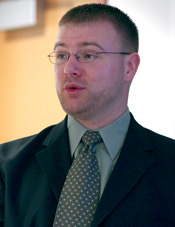Reynolds, Indiana is positioned squarely at the intersection of state highways 24 and 43. Reynolds is another of those small towns sitting on the great plain that sprawls across much of north central Indiana.
Through the years the hamlet of just 547 people really hasn’t been known for much – except Solly’s Steakhouse, perhaps. But if Indiana agricultural and energy leaders are right, Reynolds could become a model town for villages and cities around the world.
 Reynolds has been designated BioTown, USA, by Indiana government leaders in an attempt to create a town which will get all of its energy resources from renewable fuels. "It’s going to be the first in the USA and we believe first in the world," said Ryan West, Program manager for Indiana’s Bio-Energy Department.
Reynolds has been designated BioTown, USA, by Indiana government leaders in an attempt to create a town which will get all of its energy resources from renewable fuels. "It’s going to be the first in the USA and we believe first in the world," said Ryan West, Program manager for Indiana’s Bio-Energy Department.
West spoke to students, professors and staff Tuesday about the state’s bioenergy initiatives, and specifically BioTown. The state needed a small town near transportation and a willingness to think differently, West explained.
Reynolds has three substations, two main highways, proximity to I-65, three railways and a natural gas pipeline. Additionally, it was close to livestock, Purdue University, and is surrounded by agricultural land.
"We want to use waste streams and municipal waste to produce electricity and fuel," West said. The town’s one fuel station has an ethanol pump and ground-breaking is set in the next 30 days for facilities to produce electricity.
The plan is to use animal waste, municipal waste, corn stalk waste, and other materials to manufacture methane, high-value fertilizer, biogas, heat/steam, and bio oil.
The keys to meeting the November 2008 full-implementation deadline will be private investment, West said. The BioTown project is being funded entirely by Rose Energy Discovery, a private investor.
He also said a shift in people’s thinking is necessary to accept bio fuels.
An additional benefit exciting state officials is job creation. Currently, 12 ethanol plants and four bio mass facilities are proposed or under construction in Indiana. One is being built near Linden.
Those plants would create more than 600 new jobs for Hoosiers. "And those are good, high-paying jobs in rural communities," West said. "It’s great for those towns and it’s great for the environment."
Of course, there are huge expectations on the biofuel community to lead the charge negating the country’s dependence on foreign oil. The United States Department of Agriculture has set an expectation that the country would be producing 15 billion gallons of ethanol by 2010. In his State of the Union speech, President George Bush said the U.S. should be producing 35 billion gallons by 2017.
West believes, at least the first goal, is quite attainable. He hopes to help position the state as a leader in bio fuels, prove their commercial value, and grow research. The private industry buy-in isn’t just crucial to the Reynolds project, but to the future of bio fuels.
During the question and answers that followed his presentation, he addressed concerns about government subsidies. He said government resources are more likely to focus on research while private industry must grab the biofuel process potential to grow the concept elsewhere.